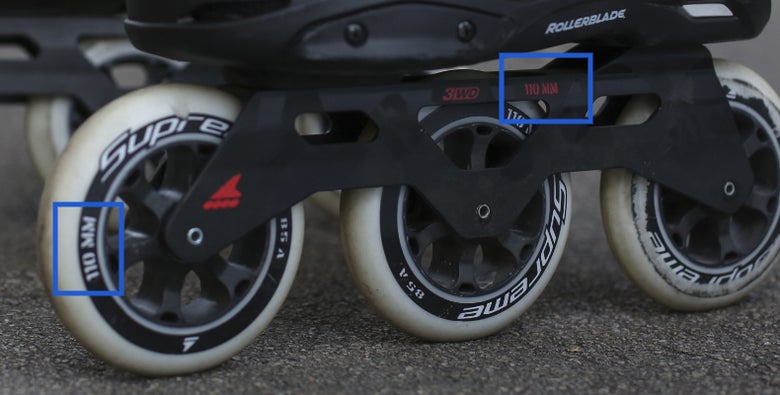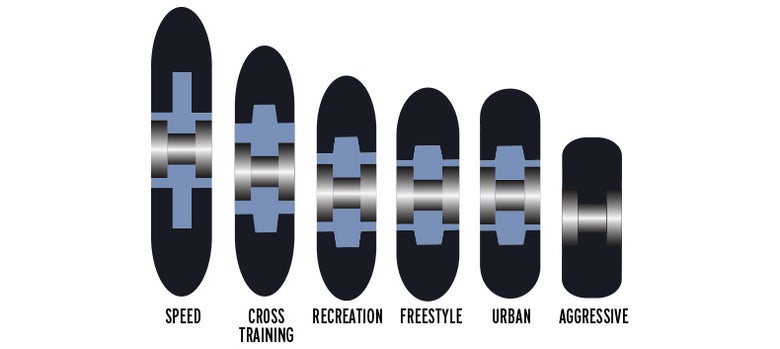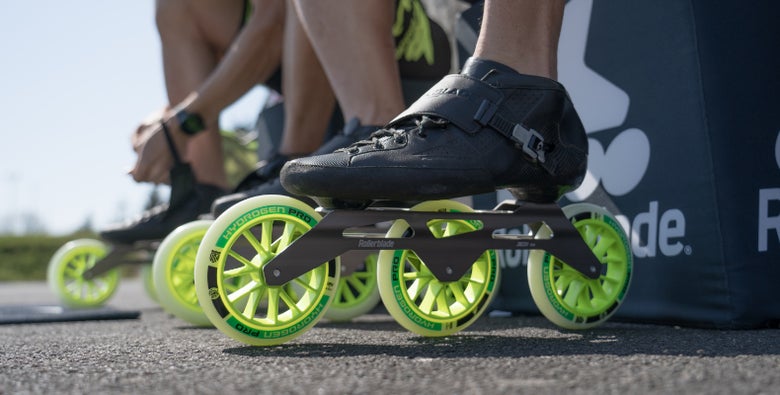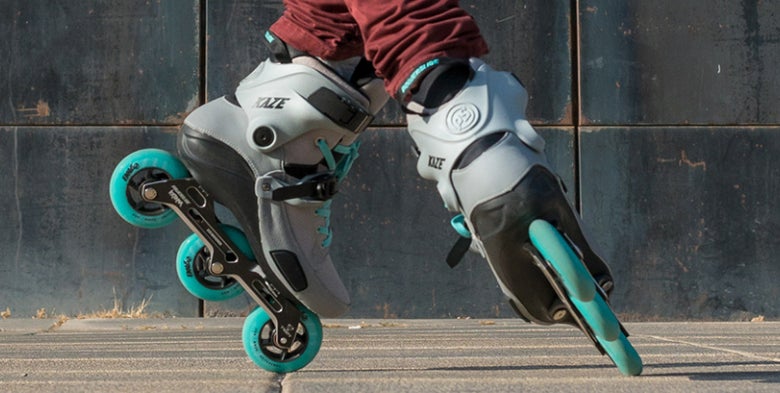Inline Wheel Buying Guide
No single inline skate wheel will work best for all skaters and no one wheel will work best in every situation. Small details such as your weight, skating surface and even temperature are all factors that can cause your friend to love a wheel that you hate! Not to worry, Inline Warehouse is here to help you weed through all of the options and find a wheel that will keep a smile on your face.
The main factors we will guide you through on this page are:
- Wheel Size
- Wheel Type
- Hardness
- Profile
- Additional Features
Wheel Size
Wheel size is measured in millimeters (mm). The size of your wheels will determine the speed, agility, comfort and stability of the skates. Most frames require the use of a specific wheel size but some allow for you to increase the wheel size if you are up for more speed and a more challenging workout. Larger wheels will also result in decreased maneuverability so be sure you are confident in your abilities before taking the jump up! To find the recommended wheel size for your skates you have two places you can look, on your current wheels or on your frames.

On the Wheels
If the graphics aren't too worn, you will find the size of the wheel printed on the face of the wheel. Most inline skates use wheels that are all the same size (flat setup), but some use Hi-Lo, 'rockered' or anti-rocker setups, which will require different sized wheels for the different wheel positions. Be sure to check all 4 wheels on your skate to ensure that they will all fit and spin without hitting your boot.
On the Frames
Wheel configurations are printed on the outside face of most frames. Looking at the image above, you can see "Max Wheel Size of 80mm" printed, indicating that 80mm wheels are to be used. Not all wheels sizes will be displayed as predominately as this example so be sure to look thoroughly to see if it is hidden in the frame graphics.
For safety reasons, always be sure to use the manufacturer suggested wheel setup for your skates. Smaller wheels may cause the brake to engage while skating since you are lower to the ground and can also allow debris to get lodged in between your wheels. If you try to install a wheel that is larger than the max size, the wheels will rub together or rub against the boot itself. If you are having trouble reading your wheel sizes or frame requirements, please send us an email at info@inlinewarehouse.com with the model name or picture of your skates prior to purchasing wheels so we can help you identify the correct size.
Wheel Types
Some wheels are specialized for a certain type of skating, while others are more versatile for use across different styles. Inline Warehouse has two pages dedicated to the different disciplines of skating. On the IW Fitness page, you will see Recreational, Cross-Training and Speed wheels predominantly featured; whereas on the IW Street page, you will be immersed in the adrenaline-filled world of Aggressive, Urban and All-Terrain skating.
IW Fitness Wheel Types
Recreational Wheels
These commonly come stock on any entry level skate and any recreational skate. Recreational wheels provide smooth, controllable roll with a focus on comfort over performance. Hardness ratings are typically 76A-80A for indoor skating with options going up to 86A for outdoor use. These wheels have a moderate profile to provide additional stability as well as easy turning.
Cross-Training Wheels
Also known as X-Training Wheels, these wheels are used for long-distance outdoor skating. Sizes range from 84-125mm with narrow profiles to boost speed and efficiency. Hardnesses typically start at 82A to enhance the performance. Being the largest category of wheels, price points will vary with size and technologies used to gain combinations of speed, rebound, durability and grip.
Speed Wheels
Sometimes called Race Wheels, these are performance driven to obtain the fastest times possible and are the most specialized wheel option. Narrow profiles are designed to limit resistance and help with cornering at high speeds. Sizes typically range from 100mm to 125mm with some 90mm options available for beginners or children. You'll find a wide variety of hardnesses for fine-tuned customization for varying surface conditions. Given the wide range or options, these wheels are labelled as Road Wheels and Track (Indoor) Wheels)
- Road Wheels are best for rough, inconsistent and dirty skating surfaces such as multi-use tracks or as you may have guessed... asphalt! These wheels tend to be softer than track wheels to help provide grip to prevent washouts.
- Track Wheels are ideal for use on smooth, grippy surfaces like gym floors and skating rinks & facilities. These wheels are harder than their Road counterparts and are able to offer better performance and speed given you have an appropriate surface to use them on.
IW Street Wheel Types
Aggressive Wheels
For use on aggressive UFS mount frames, these wheels typically range from just 54-60mm in size, with hardness ratings of 89A-100A. The small sizes and flat profiles keep the skate's center of gravity low for increased stability. Aggressive wheels are best suited for trick skates and skating at parks, on ramps and/or grinding and sliding on various obstacles and are not effective for traditional skating.
Urban Wheels
Designed to hit the streets for transportation, fitness or fun. Urban Wheels are normally 82A or harder to help hold up to rough street environments with sizes ranging from 76-125mm. The large, rounded footprint helps add control for quick reactions in crowded, urban environments.
Freestyle Wheels
Also referred to as Slalom Wheels, these are optimized to allow skaters to glide with grace and control while doing artistic dance or maneuvering cones. Wheels most commonly stay in the 76-80mm range with hardness ratings of 80-88A. Wide profiles (large footprint) are used to provide a stable platform and ultimate control for technical footwork. These wheels are almost always interchangeable with urban wheels, if you are looking for additional options for your freestyle skates, the Urban Wheels page is a great place to start!
All Terrain Tires
Inflatable tires are used in combination with specialized frames for off-road, Nordic, and trail skating. Wheels are typically over 125mm and are wider than a traditional inline wheel. Thread patterns and PSI recommendations vary from wheel to wheel. Replacement tubes are included here as well.
Hardness
Grip, speed and durability are all affected by the hardness of urethane. Typically measured as a Durometer rating, the hardness is displayed on the side of the wheel next to the size. Ratings range from 72A up to 103A; high numbers indicate a harder wheel whereas low numbers represent softer wheels. Some brands choose to use words or create their own scale to define hardness (i.e. Firm, XFirm, XXFirm, F0, F1...). For continuity, Inline Warehouse translates these to numbers to their approximate durometer rating whenever possible.
Not every hardness is ideal for all skating styles so we recommend first identifying what type of wheel you need based on the previous section and then applying some basic rules to the wheel hardness found within that discipline.
Hardness Characteristic Chart
| Hardness | Softer |
Harder |
| Speed | Low | High |
| Shock Absorption | Good | Poor |
| Grip | High | Low |
| Durability | Low | High |
Based on this chart, you can see that if you desire more speed, you should opt for a harder (higher durometer) wheel. In doing so, you should also expect less shock absorption and grip but better durability.
If you are looking for better grip, you should consider a softer (lower durometer) wheel, knowing that you will sacrifice some speed and durability but also gain some shock absorption.
Additionally, skater weight and temperature may affect the performance of your wheel and should be taken into consideration when selecting a wheel hardness.
Heavier and more aggressive skaters will put more force onto their wheels and as a result, will want to opt for a slightly harder wheel in order to maintain rebound. Lighter skaters will have a harder time getting rebound and grip out of their wheels and may opt for a slightly softer wheel.
As for temperature, extreme heat can make wheels perform as if they were softer whereas extreme cold can make wheels feel like they are harder. Ever seen a gummy bear on a hot summer's day? Well if you haven't, they get soft in the heat and in the winter, they get rock hard. The same thing happens to your wheels. While the change in your wheels may not be as drastic as with those gummy bears, it's something to keep in mind for those in who live or skate in places with extreme weather.
Profile
The profile or footprint is the shape of a wheel when looking at it straight on. This determines how much of the wheel will come into contact with the ground when skating and in turn will affect the grip, speed and stability of the wheel. You can see the footprint of the wheels on our site by looking at the second product image.
Within a wheel type, each model will have a similar shape but there will be slight differences to enhance different characteristics of the wheel, much like durometer. Here is a graphic representation of the general shapes for each skate type:

The easiest way to visualize the profile is to think about what it would look like if you dipped the wheel in paint and rolled it. Would the line of paint it leaves behind be small, indicating a pointed profile? Or wide from the wheels flat surface? This line is a direct representation of how much contact you have with the ground while skating. As you may have guessed, wider footprints are more stable and better for tight maneuvering while narrow profiles are good for speed, turning and edging.
Additional Features
Rebound
Rebound is what we call the urethane's ability to "snap back" from being compressed during your stride. The compression that occurs during striding requires energy and can result in loss of power and speed but a high rebound wheel helps reduce this loss by quickly reforming to its original shape. Higher quality wheels use complex urethanes to help keep the wheel firm while also allowing for maximum rebound.
Many skaters have experienced what we call "dead" wheels, when it feels like there is no rebound left and your wheels no longer "snap back." This is a very strong indication that it is time to replace your wheels, regardless of how much visual wear they have.
Core & Hub
The hard "plastic" feeling part in the middle of the wheel is referred to as the hub and core of the wheel. This part of the wheel that does not touch the skating surface and houses the bearing. Hubs may be solid, hollow or spoked and is typically made from nylon or plastic. High-end hubs have both stiffness and flex properties carefully built to work in concert with the urethane to optimize rebound and efficiency.
Spoked designs offer the most flex with solid offering the most stiffness. Each brand will have its own designs for hubs that vary slightly. For more information, specific differences, visit the brand pages as well as specific product pages for in-depth insights.
Inner Banding
A growing number of wheel models are using what is known in the industry as an "inner band." If you were to cut one of these wheels in half, you would be able to see that the urethane tire has an internal "band" of a different urethane.

The purpose of this manufacturing method is to blend the properties of a hard and a soft durometer into a wheel that performs better in every category: speed, grip, comfort and durability.
You may also hear this technology referred to as "dual-pour" or "dual durometer" wheels. These names reference the difference in hardness between the outer wheel and the band. Normally, the outside pour of the wheel will be harder for durability while the inside will be softer to allow for flex and rebound.
Banded wheels tend to carry a higher price tag because of the additional production costs. As the manufacturing is streamlined, some brands have been able to produce lower level banded wheels that have made their benefits accessible to a wider audience.

